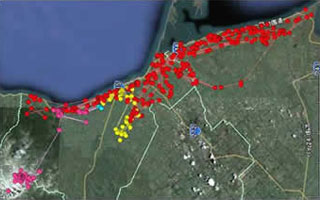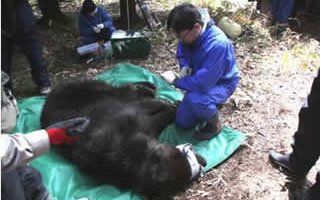
The laboratory's ultimate goal is biodiversity conservation. Toward this goal, we aim to be a center of education and research that contributes to the conservation and management of wild animals. Currently, the lab's main research areas are conservation biology and wildlife medicine. Specifically, the physiology and ecology of large mammals such as bears, deer and marine animals are studied. Also, it conducted research on the biology of pathogenic microorganism transmitted from wild animals and communications between wild animals.

Over the long course of evolution, bears have developed an adaptation called hibernation. It's a way of surviving winter, when food is very scarce. Unlike other mammals that hibernate in winter (such as chipmunks and hamsters), bears sleep through the whole winter without waking. To prepare for such a long sleep, bears eat nuts and other fatty food to put on plenty of body fat.
We aim to clarify their body fat accumulation mechanism. As a step toward this goal, we've investigated hormones involved in the metabolism of sugar and fat, and a group of enzymes related to the metabolism performed by bears' liver and adipose tissues.
Hokkaido has a rich biota of large mammals such as brown bears, deer and seals. We aim to ascertain how the risk of infectious diseases will change if the biodiversity in Hokkaido is lost or disturbed. As a step toward this goal, we've focused on Lyme disease as an epidemic model to test a hypothesis that reduction in biodiversity increases the risk of infection.


An alien invasive species artificially introduced from its original habitat may cause the biota to become more homogeneous by preying on or competing with native species, hybridizing with closely related species or manipulating habitats. In Hokkaido, where North American raccoons have gone feral, there's the problem of population increases due to these raccoons' high fertility. To address problems related to alien invasive species, there's the need to prevent more invasion (which will reduce the biodiversity), to exclude already settled invasive species and to do scientific management. The laboratory has analyzed demographic data needed to manage wild raccoon populations.
The ADPS (Animal Direct Positioning System) Project is a joint research project conducted by the laboratory, the Shibetsu Brown Bear Information Center and NTT Docomo, Inc. Under the project, local brown bears are fitted with cellular GPS transmitters so that their home range can be known on a real-time basis by computer. The purposes are 1) to clarify the seasonal home ranges of local brown bears, which are uncertain, and 2) to alert local residents and tourists of bear appearances.

Brown bears fitted with GPS transmitters are tracked.

A sedated bear is fitted with a GPS collar.

The Rusha area on the Shiretoko Peninsula is designated as a special protection area within the wildlife sanctuary of Shiretoko National Park. Accordingly, it's a location that people can't enter easily. No longer hunted, brown bears are completely protected from humans. Therefore, brown bears live without worrying about humans. We observed the brown bears at close range to clarify their habitat use and relationship between individual bears. We took a bit of fur from brown bears by dart biopsy and have done gene analysis.

The development of tuberculosis in Asian elephants is an issue in Nepal. In many cases, the causative microorganism is Mycobacterium tuberculosis. This strongly suggests that tuberculosis was spread from elephants raised for sightseeing to humans or from humans to elephants. The route and mode of infection are still unclear. Epidemiological study is required.
Our objective is to sample the blood and nasal secretions of local elephants, to identify the pathogens and to analyze their genotypes.
Over the long course of evolution, bears have developed an adaptation called hibernation. It's a way of surviving winter, when food is very scarce. Unlike other mammals that hibernate in winter (such as chipmunks and hamsters), bears sleep through the whole winter without waking. To prepare for such a long sleep, bears eat nuts and other fatty food to put on plenty of body fat.
We aim to clarify their body fat accumulation mechanism. As a step toward this goal, we've investigated hormones involved in the metabolism of sugar and fat, and a group of enzymes related to the metabolism performed by bears' liver and adipose tissues.